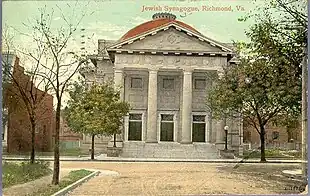| Congregation Beth Ahabah | |
|---|---|
 Early 20th century postcard of the current synagogue | |
| Religion | |
| Affiliation | Reform Judaism |
| Ecclesiastical or organizational status | Synagogue |
| Status | Active |
| Location | |
| Location | 1121 West Franklin Street, Richmond, Virginia |
| Country | United States |
 Location in Virginia | |
| Geographic coordinates | 37°33′05″N 77°27′20″W / 37.551278°N 77.4555°W |
| Architecture | |
| Architect(s) | Noland and Baskervill |
| Type | Synagogue |
| Style | Roman Revival |
| Date established | 1789 (as Kahal Kadosh Beth Shalome) |
| Groundbreaking | March 4, 1904 |
| Completed | December 9, 1904 |
| Specifications | |
| Dome(s) | One |
| Materials | Stone |
| Website | |
| bethahabah | |
Congregation Beth Ahabah | |
| NRHP reference No. | 72001528 |
| Significant dates | |
| Added to NRHP | September 14, 1972 |
| Designated CP | West Franklin Street Historic District |
| [1][2][3] | |
Congregation Beth Ahabah (meaning "House of Love") is a Reform Jewish synagogue at 1121 West Franklin Street, Richmond, Virginia, in the United States. Founded in 1789 by Spanish and Portuguese Jews as Kahal Kadosh Beth Shalome (meaning "Holy Congregation, House of Peace"), it is one of the oldest synagogues in the United States.[4]
History
When the congregation was founded, there were 100 Jews in Richmond's population of 3,900. After meeting for some years in leased space, the congregation built its first synagogue in 1822. It was a handsome, if modest, one-story brick building in Georgian style.[5]
The community grew and in 1841 the Ashkenazi members founded a new congregation called Beth Ahabah. In 1846 Beth Ahabah established the first Jewish school in Richmond, and 1846 built a synagogue at Eleventh and Marshall Streets. The Congregation moved toward Reform in 1867 with discussion of acquiring an organ, the decision to switch to family pews (mixing men and women) and allowing women to join the choir. Beth Ahabah joined the Reform Movement Union of American Hebrew Congregations in 1875. A new building was erected, also at Eleventh and Marshall, in 1880. In 1898 K.K. Beth Shalome formally merged with Congregation Beth Ahabah.[5]
On March 4, 1904 the congregation laid the cornerstone for its present building, known as the Franklin Street Synagogue. The building was dedicated on December 9, 1904.[1] The domed, Neoclassical synagogue was designed by the Richmond-based firm of Noland and Baskervill (now Baskervill), who also designed nearby St. James' Church and the wings of the Virginia State Capitol. The synagogue has 29 stained glass windows. Most notable is a window on the building's eastern wall created and signed by the Louis Comfort Tiffany Studios in 1923. It depicts Mt. Sinai.
The congregation maintains the Hebrew Cemetery of Richmond, including the Cemetery for Hebrew Confederate Soldiers, as well as the original site of the 1789 Franklin Street Burial Grounds, which was the first Jewish cemetery in Virginia.
Beth Ahabah Museum
Congregation Beth Ahabah is the home of the Beth Ahabah Museum & Archives, located at 1109 West Franklin Street. Established in 1977, the museum's focus is the history and culture of Richmond's Jewish community and the Southern Jewish experience. Three galleries feature changing exhibits. The museum is open from Sunday through Thursday.
Notable members
- Bret Myers (born 1980), soccer player and professor
References
- 1 2 "The Synagogue". Beth Ahaba. Archived from the original on October 1, 2011. Retrieved July 1, 2011.
- ↑ "West Franklin Street Historic District National Register Nomination" (PDF). Virginia Department of Historic Resources. Archived from the original (PDF) on June 9, 2012. Retrieved July 1, 2011.
- ↑ "National Register Information System". National Register of Historic Places. National Park Service. March 13, 2009.
- ↑ Olitzky, Kerry M.; Raphael, Marc Lee (June 30, 1996). The American Synagogue: A Historical Dictionary and Sourcebook'. Greenwood Press. p. 359.
- 1 2 "Our History". Congregation Beth Ahabah, Richmond, Virginia (VA). Archived from the original on July 23, 2013. Retrieved December 24, 2013.